Having just returned from the Interbay P-Patch’s annual lavender fundraiser, I found myself reflecting on being bathed in pollinators– buzzing, flitting, circling, delighting (the latter, my interpretation). In the world of stormwater, approaches that slow, infiltrate, and filter polluted stormwater runoff is embodied by Low Impact Development (LID) and broader Green Stormwater Infrastructure (GSI). Many GSI elements include native plants that attract pollinators. Not only are these practical ways to reduce stormwater pollution, but they can also serve to beautify an urban landscape.
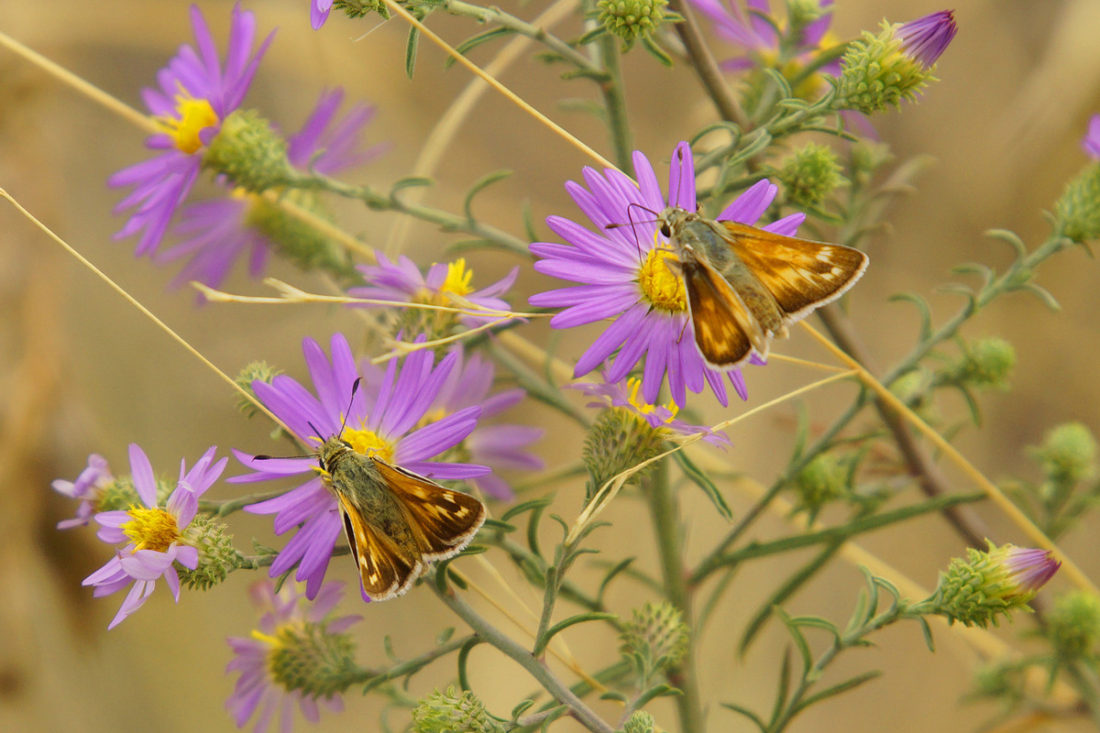
These facilities offer so much more than pollution reduction. Both LID and GSI are on-site approaches that slow, infiltrate and filter stormwater. The processes inherent in both are beneficial for reducing the quantity of polluted and flashy runoff to local waterways and improving water quality. In many cases, such as rain gardens, bioretention, and green roofs, installations offer additional benefits (called “co-benefits”) such as recreation and gathering spaces, habitat, cooling shade, and just sheer beauty.
These facilities often reduce the costs associated with stormwater pollution in addition to attracting soil microorganisms, pollinators, and aesthetics that people seem to like.
Since 2016, the Stormwater Strategic Initiative Lead Team (SIL) has supported through funding, over $5 million worth of GSI projects, initiatives, pilots, and overall capacity building in this important area. Many GSI projects use plants, water, rocks, compost, and other natural elements that are attractive to communities.
Biophilic elements – things from the natural world that are alive- work to stimulate our sympathetic system when we need cognitive function, as well as our parasympathetic system which relaxes us. Some practitioners call it a sense of relaxed awareness. According to a paper on the economics of biophilic design, viewing natural patterns and objects triggers receptors in the visual cortex which causes pleasure.
I thought this was a great companion to the use of the design principle of the mathematically infamous Golden Rectangle, a 5 x 8 ratio, which appears to have universal appeal, hastens how quickly we view an image and may be linked to the physical response we have when we view something beautiful. In other words, beauty physically moves us.
Thanks for our amazing project and program partners!
Are you interested in implementing a GSI project in your area? Learn more about some of the amazing work happening throughout Puget sound that the Stormwater Strategic Initiative has funded to inspire you!
You can contact any of the partners below for more information or contact our team.
You can also search for project overviews on our site on our funded projects page. Search for Stormwater under Strategic Initiatives when you are searching and put a search term and voila! project information at your fingertips.
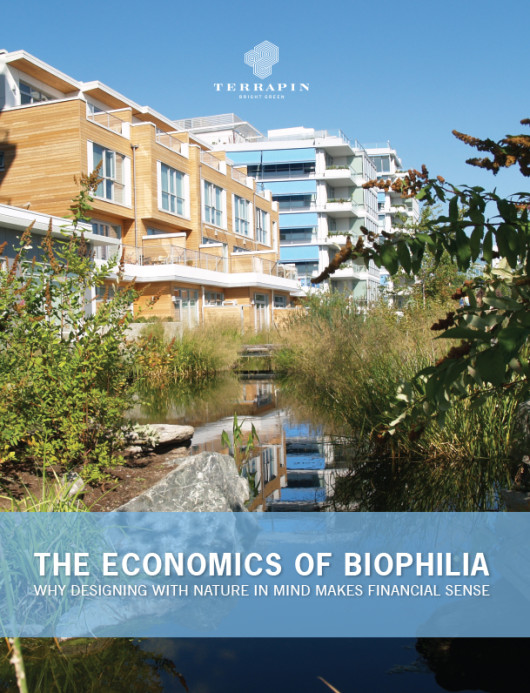
New Program Approaches
The projects funded span most of Puget Sound’s 12 counties and are being undertaken by a wide variety of partners such as Conservation Districts (CDs hereafter) , Salmon Enhancement Groups, nonprofits, cities and counties, Universities and state agencies.
Several projects established programs, such as Green Link in Port Angeles and Shelton’s new GSI program. Green Link implements Port Angeles’ watershed plan. In Phase I, both programmatic and site-specific projects will be identified and prioritized to improve water quality, habitat, and community assets. Phase II will support the implementation of priority projects identified in Phase 1. In Shelton, the Mason Conservation District is developing a GSI framework to support future stormwater projects. The GSI framework will inform new project prioritization, including the ranking of locations to be targeted, and the construction of rain gardens in priority neighborhoods.
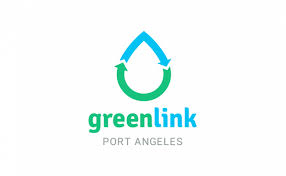
Evaluating Best Practices and Building Capacity
Several projects evaluated practices to improve their future use. We had several permeable pavement projects.
Permeable Pavements Lessons Learned
The Permeable Pavements Lessons Learned project with the Washington Stormwater Center and the City of Tacoma Included mix design for permeable pavements, addition, and revision of testing procedures for acceptance by the practitioners, best practices, recommended future research and recommendations for communicating results. An added benefit is that the project is located at the iDEA school (Industrial Design, Engineering and Art) in Tacoma. Students will be doing the operations and maintenance for the project.
Depave and LID Retrofit Project
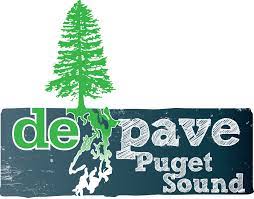
Related to this project, the Depave and LID Retrofit project developed a detailed Depave Guide, and installed LID stormwater retrofits in three locations including depaving impervious surfaces to plant trees, open green space, and construct school playgrounds and a raingarden. Stormwater problems are squarely related to impervious surfaces which are super-energetic highways of pollution to streams and Puget Sound. Each time you remove 1,000 sq ft of pavement you prevent 24,000 gallons of polluted stormwater from going into Puget Sound.
Yard Smart Program

GSI rebate structures were analyzed in Kirkland’s Yard Smart Program. Interestingly, results indicated that residents understand how serious our water quality programs are and that individual actions have an impact on water quality. The project uncovered the interlocking barriers that prevent residents from taking advantage of rebates which will help shape changes in future rebate structures through the report’s recommendations. The team took these recommendations and implemented the Kirkland Yard Smart Program working with private landowners to install GSI on their property to improve water quality.
Puget Sound Stormwater Action Team
Led by the Snohomish Conservation District, six Conservation Districts joined together to build capacity as the Puget Sound Stormwater Action Team. The Puget Sound Conservation District (PSCD) Stormwater Action Team worked together as an interdisciplinary team of experts to raise the capacity of stormwater services within CDs and their partners across Puget Sound. The PSCD Stormwater Action Team replicated proven programs and services to construct GSI projects in partner districts and provide training and resources to encourage partner CDs to develop their own GSI programs.
King County Projects
The Washington Stormwater Center with WSU Extension will be working to expand the use of GSI in South King County. This project aims to: attain a better understanding of the public’s attitudes towards GSI and stormwater management, develop a scalable, portable landscape-level method for locating and selecting GSI based on hydrological, societal, and economic controls, and distribute project results and findings through innovative and effective education and outreach activities.
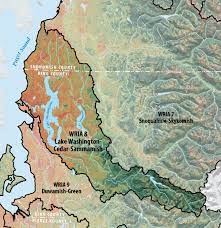
Different approaches are needed for more rural, unincorporated King County to advance GSI, particularly around rebate structures and delivery mechanisms. Snohomish CD will work with King County and Dirt Corps to identify barriers to installing GSI in order to circumvent them installing GSI in priority watersheds. A past successful community engagement technique of using of Veterans and non-governmental staff will be replicated in this project to emphasize community-facing engagement practices.
In WRIAs 8 and 9 (the most heavily urbanized of King County’s watersheds), the Mid Sound Fisheries Enhancement Group will install GSI retrofits on private property to reduce stormwater input of toxics, improve water quality and improve stream flow in priority salmon habitat areas.
San Juan County Projects
In San Juan County, many stormwater improvements are taking place in Lopez Village on Lopez Island. The County transformed 1,000 feet of a grass lined roadside ditch into a bioswale planted with native vegetation. The bioswale increases stormwater runoff and infiltration for runoff in the basin. Also in this location, a large parking lot will be depaved and an LID retrofit constructed to minimize sheet flow that discharges into a wetland and Fisherman’s Bay on Lopez Island.
Kitsap County Projects
In 2017, the Suquamish Tribe completed a watershed protection and restoration plan for Blackjack Creek in Kitsap County. The Kitsap CD will implement LID in the Lower and Middle part of the Creek, including free online workshops and virtual site tours, technical assistance, cost-share assistance and “Dig Days,” where the Kitsap CD installs rain gardens.
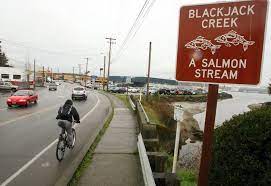
In other island news, Bainbridge Island implemented rain gardens on private property in the Manzanita watershed. The project will also assess an “out of the basin” (off-site) mitigation program that could fund additional retrofit programs in the watershed.
The City of Poulsbo completed several bioretention projects to improve water quality in Liberty Bay and Bjorgen Creek through installation of a bioretention swale along Fjord Drive and a water quality treatment vault at the North Kitsap Middle School campus (called a BioPod Treatment Vault). The projects provided treatment for Total Suspended Solids, oil, dissolved copper, dissolved zinc and Total Phosphorus. The BioPod is near the Middle School’s outfall and will permit easy future expansion.
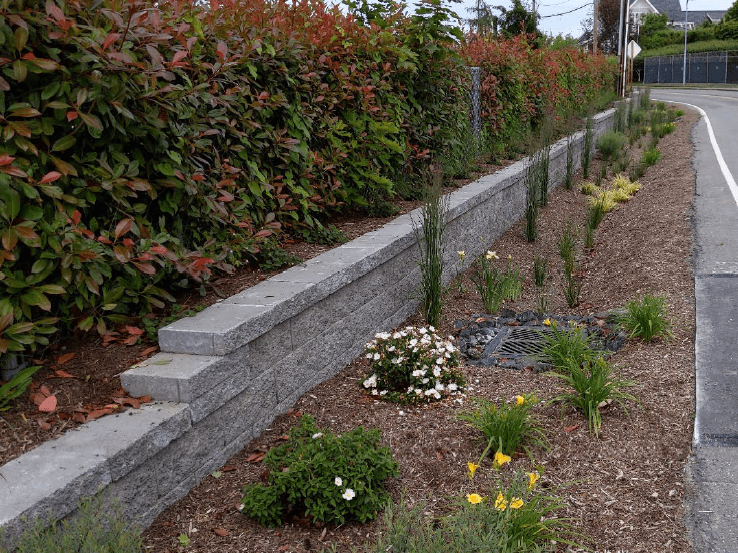
Snohomish County Projects
In Snohomish County, the Latino Education and Training Institute, with WSU Extension and Snohomish CD will teach Latino community members about stormwater pollution impacts, sources, and reduction. They will use effective community-led and based strategies, including Spanish GSI workshops.
In the Perrinville Creek watershed, Snohomish CD partnered with the City of Edmonds and to install two highly visible GSI projects following their 2016 GSI feasibility study. The Perrinville Basin is a watershed that has been prioritized for green stormwater projects across jurisdictions to reduce severe sedimentation, flooding, and may improve fish passage issues.
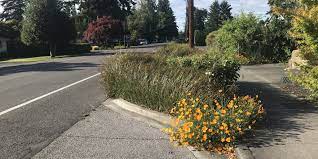
Commercial property owners will be the focus of Snohomish CD’s parking lot retrofit program in the Bear/Little Bear Watershed. Snohomish CD will use a social marketing study to better understand how to engage diverse commercial property owners and the CD’s Veteran Conservation Corps will implement on the ground GSI.
Urban Applications of GSI

The Washington State Department of Commerce produced a Building Green Cities Handbook designed to increase the use of GSI in urbanized areas. Working with the Puget Sound Regional Council, the project used social marketing to identify the values, barriers and incentives that would inspire developers to use GSI beyond their legal requirements. The Handbook serves to build capacity in jurisdictions to promote and market GSI tools.
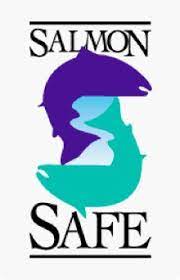
Salmon-Safe, a non-profit which has a Salmon-Safe certification program, is implementing its Clean Water for Salmon program to help shift Puget Sound development practices to “beyond code,” stormwater management, habitat conservation, and water quality protection practices. The project includes a campaign to transition 25 new and retrofit Seattle-area development sites to Salmon-Safe standards and engaging local governments.
Heidi Siegelbaum and Justin Donahue, Stormwater Strategic Initiative Lead Team
For questions about these projects please contact the project proponents or Justin Donahue at Ecology.
These projects have been funded wholly or in part by the United States Environmental Protection Agency under the assistance of PC-01J18101 to the Washington State Department of Ecology. The contents of this blog and associated documents connected to these projects do not necessarily reflect the views or policies of the Environmental Protection Agency, nor does mention of trade names or commercial products constitute endorsement or recommendation for use.

